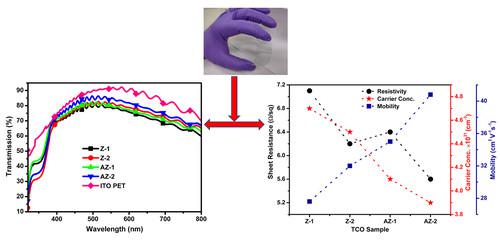Multilayer and Thin Transparent Conducting Oxide Fabrication Using RF Magnetron Sputtering on Flexible Substrates
引用次数: 1
Abstract
In this work, the fabrication of multilayered transparent conductive oxides (TCOs), ZnO–Ag–ZnO (Z-TCO) and AZO–Ag–AZO (AZ-TCO), on flexible polyethylene terephthalate (PET) substrate using radio frequency (RF) magnetron sputtering is reported, with the optical and electrical properties comparable to those of the commercially available Sn-doped indium oxide (ITO) on the PET substrate. The growth of Z-TCO and AZ-TCO layers on PET (with surface roughness ~5 – 7 nm) shows similar surface characteristics to that on the glass substrate. The multilayered Z-TCO and AZ-TCO (total thickness ~70 nm) with 10 nm of Ag thickness (named Z-2 and AZ-2, respectively) exhibit a maximum transparency of 82.7% and 86.4%, at 515 and 498 nm, respectively. The AZ-2 layer has a lower electrical resistivity of 3.92 × 10−5 Ω cm with a lower sheet resistance of 5.6 Ω/sq, whereas for ITO on PET these values are 2.62 × 10−4 Ω cm and 14.5 Ω/sq, respectively. The AZ-2 layer also gives an excellent figure of merit (FoM) of 21.3 × 10−3 Ω−1, which is better than the FoM for ITO PET (17.3 × 10−3 Ω−1). Therefore, the flexible multilayer TCOs prepared using RF magnetron sputtering on PET substrates on a large area can have better optoelectronic properties than commercial flexible ITO coating and can be used in flexible optoelectronic devices.

利用射频磁控溅射在柔性衬底上制备多层和薄透明导电氧化物
在这项工作中,报道了使用射频(RF)磁控溅射在柔性聚对苯二甲酸乙二醇酯(PET)衬底上制备多层透明导电氧化物(TCO)、ZnO–Ag–ZnO(Z-TCO)和AZO–Ag-AZO(AZ-TCO),其光学和电学性能与市售的PET衬底上的Sn掺杂氧化铟(ITO)相当。Z-TCO和AZ-TCO层在PET上的生长(表面粗糙度~5 – 7. nm)显示出与玻璃基板上的表面特性相似的表面特性。多层Z-TCO和AZ-TCO(总厚度~70 nm)与10 nm的Ag厚度(分别命名为Z-2和AZ-2)在515和498处表现出82.7%和86.4%的最大透明度 nm。AZ-2层的电阻率较低,为3.92 × 10−5Ω cm,较低的薄层电阻为5.6Ω/sq,而对于PET上的ITO,这些值为2.62 × 10−4Ω cm和14.5Ω/sq。AZ-2层也给出了21.3的优良品质因数(FoM) × 10−3Ω−1,这比ITO PET的FoM(17.3 × 10−3Ω−1) 。因此,使用RF磁控溅射在PET衬底上大面积制备的柔性多层TCO可以具有比商业柔性ITO涂层更好的光电性能,并且可以用于柔性光电器件。
本文章由计算机程序翻译,如有差异,请以英文原文为准。
求助全文
约1分钟内获得全文
求助全文

 求助内容:
求助内容: 应助结果提醒方式:
应助结果提醒方式:


